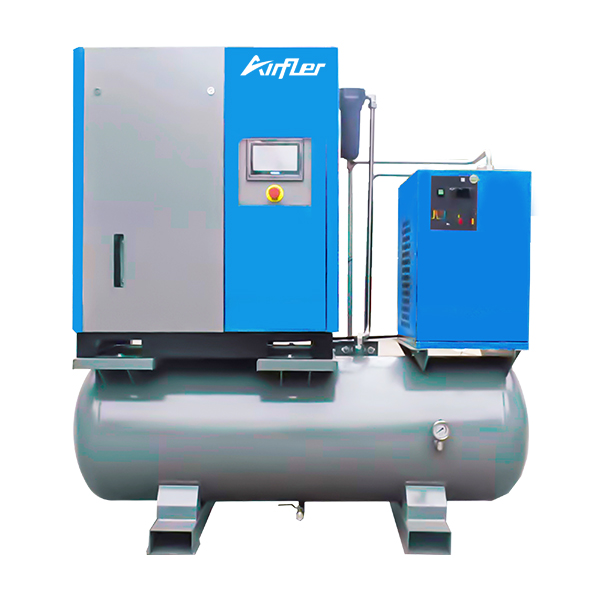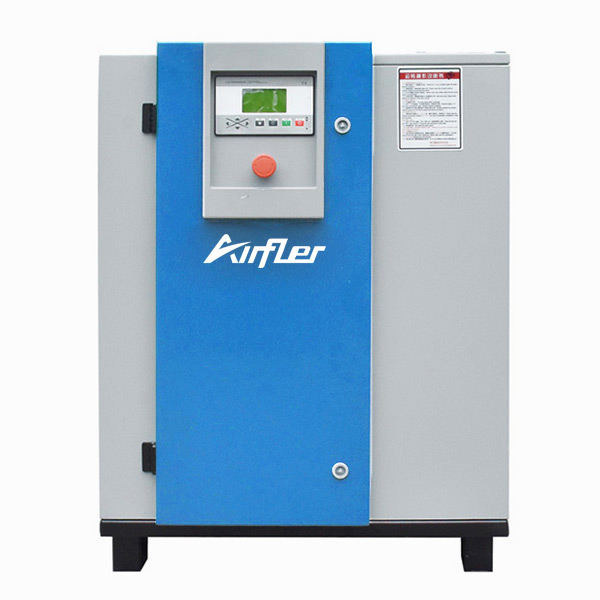Air compressors power a wide range of industries from large industrial production machinery to individual ratchets and impact wrenches, paint sprayers and nails. In this wide range of applications, you often find several other major advantages of air systems: versatility and power. Regardless of the scope or location of your project, the air compressor can accommodate all compatible tools-just as quickly and easily as changing drill bits. In addition, aerodynamic models typically provide greater torque and higher RPM than standard tools.
Three types
There are three basic types of air compressors:
Reciprocating-positive displacement compressors provide increased air pressure by limiting the amount of air. They are divided into single and two stages and are usually capable of outputting 1 to 15 hp.
Rotary screw-positive displacement compressor, considered easy to operate and maintain. Favored for its ability to provide continuous work, its design provides cooling inside the compressor, protecting individual parts from extreme operating temperatures and enabling them to provide output powers of 7.5 to 100 hp and higher .
Centrifugal-The compressor does not rely on positive displacement and is most effective at full load operation, so it is ideal for continuous demand and output environments of approximately 100 hp.
Generally, air compressors are highly durable tools. For example, it is estimated that rotary compressors will last 40,000 to 60,000 hours-equivalent to 20 to 30 years of full-time operation. With regular maintenance, the life expectancy of reciprocating compressors is 10 to 15 years. Each of the three types has many advantages and disadvantages, which we will detail below.
Which of the following may apply to you?
Variable speed drive
This development uses variable speed technology and special drives to control the speed of the device, which can save a lot of energy compared to fixed speed air compressors-up to 35% compared to some models. Because of the huge savings potential, some dealers consider variable speed drives to be "outperformed by all other control technologies" on the market today.
In short, variable speed drives automatically pair their output with the user's air needs. The continuous, real-time nature of this development provides unparalleled energy efficiency, reducing the need for power and fuel, while also reducing emissions. It has unlimited motor starting capability, the ability to go from zero to full load without current spikes or generating excess heat, further saving cost and energy.
4-tier engine
Tier 4 is known for complying with EPA guidelines on emissions control. But Tier 4 engines (usually made by leading brands such as Caterpillar and John Deere) are also fuel efficient, which can save the total cost of ownership of diesel air compressors.
Many top-tier air compressors with Tier 4 engines can easily reach 300 to 425 cfm at 100 to 200 psig. They feature advanced electronic control systems, including easy-to-read gauges and an LCD display, allowing users to quickly adjust specific factors to achieve the best combination of performance and cost effectiveness.
Although not everyone comes standard, some models further expand their value by enhancing the design. These can include frames designed to fully contain liquids, as well as easy-to-use access doors that simplify maintenance and servicing of fuel tanks, engines, air filters and other important compartments.
Greater capacity, lower power requirements
The goal of almost every technology is to produce more for less. Air compressor manufacturers pursue this goal by providing higher levels of output with less fuel. One way they do this is by lowering the operating temperature. By redesigning the compressor with a lower internal temperature, the new model can significantly increase volume and electrical efficiency.
Another aspect can be seen in the trends we introduced above: variable speed drives. Consider, for example, a rotary screw air compressor. They are often integrated into woodworking and painting operations, body repair and repair shops, and even larger industrial operations, and they are usually not continuous-use machines that must operate at full capacity. In this case, variable speed drives can compensate for changing power demands and are realized through monetization, which saves fuel, not to mention unnecessary wear on machine parts. As mentioned above, this technology can reduce energy costs by more than a third, and some variable speed compressors can even run with 40% less energy than standard compressors.
Oil-free rotary screw compressor
By long-term processing of Teflon or similar synthetic resins, it is possible to permanently lubricate essentially maintenance-free, oil-free or "oil-free" air compressors. Oil-free models are not ideal for continuous use, but they are suitable for short-term use and home use. They have also become one of the preferred types of painting equipment and other operations that require a clean working environment. The reason is that oil-lubricated compressors emit small amounts of oil in the form of mist, a design limitation that makes some applications difficult to handle.
In addition to virtually non-existent maintenance costs, oil-free compressors also tend to be cheaper because they require fewer parts for design. This minimalist design also makes it lighter and is perfect for those who need to carry it.
kind
As mentioned briefly in the introduction, there are three main types of air compressors:
Reciprocating compressor
Rotary screw compressor
Centrifugal compressor
Of these three types, there are two different breeds. The more common of the two, including two of the three types, works by using a positive displacement.
Positive displacement is a mechanical design that generates air pressure through a pump, which is divided into suction and discharge sides. During the compression stroke, these two sides or cavities expand and decrease as air is drawn into the suction chamber and released on the discharge side. Positive displacement is common in reciprocating and rotary screw air compressors because it is suitable for compressing small amounts of air to high pressure and has the ability to quickly dissipate the heat generated by compression.
With that in mind, the air compressor you choose will be determined by many specific factors, including power output requirements and portability.
This is how these three types are compared.
Reciprocating air compressor
The reciprocating compressor is a positive displacement model. The same amount of air enters the compression chamber, leaves the cylinder and is pressurized to the necessary PSI. The reciprocating model usually falls on the smaller end of the output scale and has one of two different cylinders:
Lubrication-The abbreviation for "oil lubricated compressor" uses oil to maintain the integrity of the cylinder, piston and piston ring. The benefit of this design is that, in addition to having to maintain the filtration system on a regular basis, it usually requires very little maintenance.
Non-lubricated-Teflon piston rings are used instead of oil. This type does not require lubrication and is generally lighter in weight due to the use of aluminum components instead of cast iron. Similar to the service requirements for lubricated models, Teflon rings must be replaced constantly.
Positive displacement helps to dissipate heat, and cylinders filled with water are often used to avoid accumulation. The reciprocating compressor also includes an intercooler and an aftercooler between each stage. These aftercoolers serve as the final filters for heat and moisture before the compressed air is discharged. In terms of capacity, these are the short-term operating modes of the group, with a maximum power of 50 hp and a maximum CFM of 12,000 CFM at 125 psig.
Rotary screw air compressor
The second type of positive displacement compressor, the rotary screw air compressor has two or more interlocking screws built in to suck air into the system. When external air is drawn into the system, its degree of compression increases and it is discharged at the required psi pressure. Similar to the reciprocating type, the rotary screw model is also divided into two unique types:
Overflow-An overfilled compressor pairs oil with compressed air, passes it through the system, filters it out, and then drains it back to the tank for continued use. Regular maintenance of such compressors includes routine replacement of oil, filters and separators.
Oil-free-This type is exactly similar to the oil-filled type, with one major exception: the oil is replaced by a non-contact carbon ring seal, eliminating the possibility of the oil entering the compressed room air. One disadvantage of this type is that because it does not have the ability to throttle the inlet, it tends to accumulate too much heat, which often makes the overflow type the first choice.
Rotary screw air compressors have a much larger capacity than reciprocating compressors, can provide 7.5 to 100 hp, and can discharge up to 2500 CFM at 125 psig.
Centrifugal air compressor
Oddly, the centrifugal compressor is the largest of the three and is powered by an electric motor or steam turbine, producing up to 500 hp and 15,000 CFM output at 125 psig. This huge pressure is mainly used in large industrial manufacturing processes and is generated by staged compression, which usually requires 2 to 5 stages.
Unlike the positive displacement type, the centrifugal model contains at least two impeller assemblies that rotate to compress the incoming air. This rotation produces speed, which in turn generates energy that is used to pressurize the air. The advantage of this design is that its capacity is highly customizable and can be easily adjusted by adjusting the air inlet or outlet and speed.
Centrifugal compressors are much more expensive than the other two models. And upfront costs are just the beginning. They require constant maintenance and often require expensive repairs to individual parts due to high speed and continuous use practices.
Other options
Although all air compressors are represented by one of the three types mentioned above, they also come in different designs to meet the needs related to portability, size and weight. The most common designs include:
Portable-Portable air compressors are designed to be lightweight and easily transfer from one job to the next, usually mounted on a bracket with 2 to 4 wheels. The obvious advantage is being able to take it anywhere and power pneumatic tools in an endless working environment without the need for extra long hoses to protrude from a fixed location or a compressor mounted on the truck. This type usually belongs to the reciprocating series, so it has less total power than the larger models.
Stationary-Stationary air compressors are designed for long-term projects and offer far more CFMs than their portable cousins. They also require special installation considerations, which usually include additional hoses that drill through the wall and mount above the work area. High-end rotary screw compressors are usually this type.
On-board compressors – On-board compressors are similar to stationary compressors, except that they can be easily taken from one site to another without disassembly and reassembly. In addition, larger models can power multiple pneumatic tools at once. In the installed compressor, some electrical equipment is more environmentally friendly, which allows you to save fuel costs during continuous use. However, just like the fixed model, you have to lay hoses from the truck to the work area, and take into account that the pressure loss due to the length of running time may be between 0.7 and 25 CFM.
Trailed-Trailed air compressors are commonly found in construction sites or forestry applications and are mounted on top of trailers with heavy steel chassis and fully galvanized canopies. They usually have simple connections, such as a pendant suspension, that can be mounted on any large work vehicle, and provide output from 14 to 327 hp and output from 50 to 1,200 CFM (125 psig).
back to the top
There are several key areas where you can compare the value and availability of air compressors. Therefore, when comparing different models, you should pay attention to the following points.
stage
The term "stage" is used to describe a cylinder in an air compressor. You have two options: single-phase and multi-phase.
Single-stage compressors consist of only one compressed air cylinder, typically up to 120 psi. Often, this is sufficient for home use or small stores that only provide one tool at a time. If you are looking for portability (and an air compressor that can be easily carried and lifted), one step is the way.
Multi-stage compressors are designed for a variety of pneumatic tools and require pressures above 120 psi. For more than one cylinder, the air is first compressed in the initial cylinder and then compressed in each successive cylinder for higher power. Multi-stage compressors generate more heat and require cooling components due to the additional mechanical processes involved, often in the form of radiators.
power
If you plan to use the compressor in an enclosed area, this may be up to you, as the enclosed area immediately produces gas and diesel-driven compressors, so they produce exhaust and are therefore unqualified. The output power usually also determines the power source, and the horsepower of the diesel engine is greater than the electric model.
Generally, you can choose between three options:
Natural gas-In rural areas and job sites that are not connected to the grid, a portable gas compressor is usually a good choice. Unfortunately, in some cases, they can weigh more than 200 pounds. You will find two different types: a type with a generator to power the cylinder and a type that directly powers the cylinder. The disadvantage of this setup is that they tend to produce more noise than other models, and they also need to store and transport additional fuel. However, if you need a multi-stage compressor, this may be one of your only options.
Diesel-Diesel models typically provide the highest level of output, usually in the range of 185 to 1,600 CFM-far exceeding the output of gasoline or electric compressors. That's why diesel is usually the source of power behind truck installation and traction models, enabling them to provide higher torque and greater capacity for a variety of pneumatic tools connected simultaneously. Similar to small gasoline engines, you need to prepare excess fuel at all times. However, diesel models are usually designed with smaller fuel tanks, which can be effectively installed on various work vehicles.
Electric – This is reported to be one of the most common types of air compressors because they are generally lighter and more compact, so they are environmentally friendly and can be safely used in enclosed spaces. Most power supplies can only be powered by plugging them into a standard wall outlet, although larger models that produce higher CFMs may require higher voltages. It is worth noting that this type of compressor requires longer air hoses, as some experts do not recommend using extension cords in air compressors.
Buying Tip: Make a list of every pneumatic tool that needs to be powered at the same time and plan ahead. No matter what kind of power source you buy, an under-purchase will quickly burn your compressor. Overpurchasing can be just as bad. You don't have to pay for excess petrol, diesel or electricity.
CFM, PSI and horsepower
CFM or cubic feet per minute is a measure of throughput relative to the inlet. In short, it measures flow, not volume. PSI, or pounds per square inch, is the pressure generated by a pound of force directed toward a square inch area. This leads to a measurement of the flow resistance.
Finally, horsepower. A leading air compressor manufacturer says horsepower is important, but when comparing different compressors, horsepower is not as important as CFM. Larger air compressors usually have higher horsepower and lower CFM. Unfortunately, these models tend to be hotter and publish faster than others. Therefore, when buying a new or used air compressor, first pay attention to the CFM rating, and secondly, pay attention to all other matters.
 English
English 简体中文
简体中文 French
French English
English Portuguese
Portuguese Russian
Russian Spanish
Spanish






